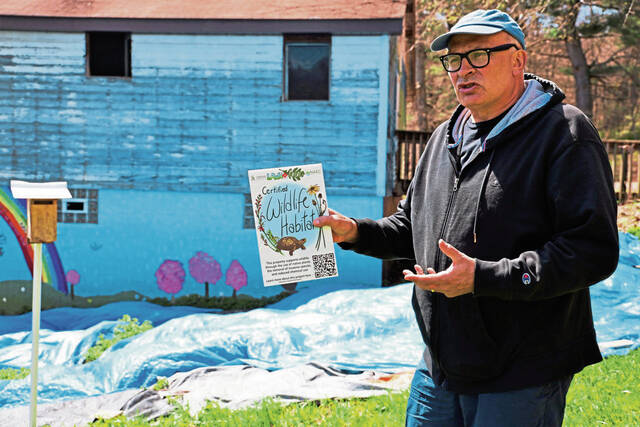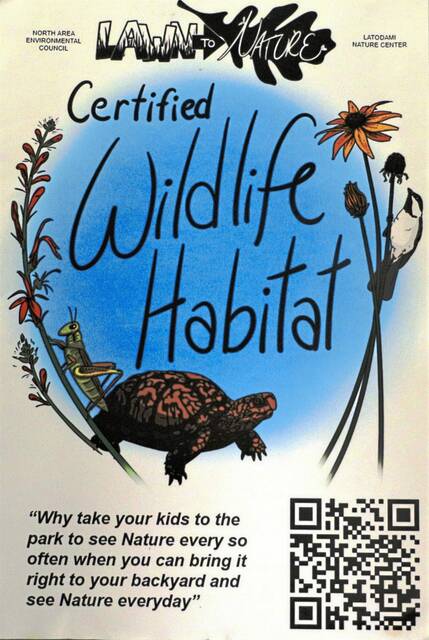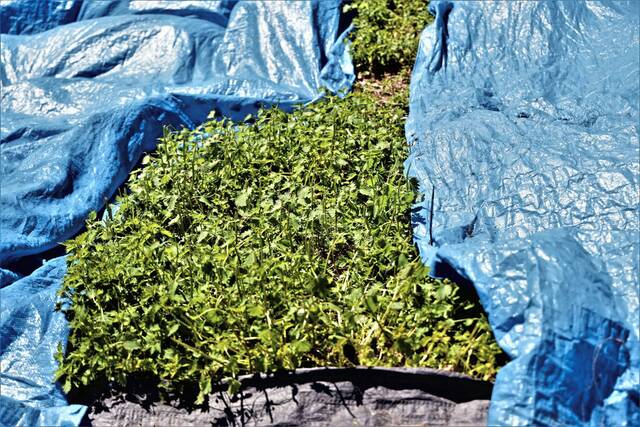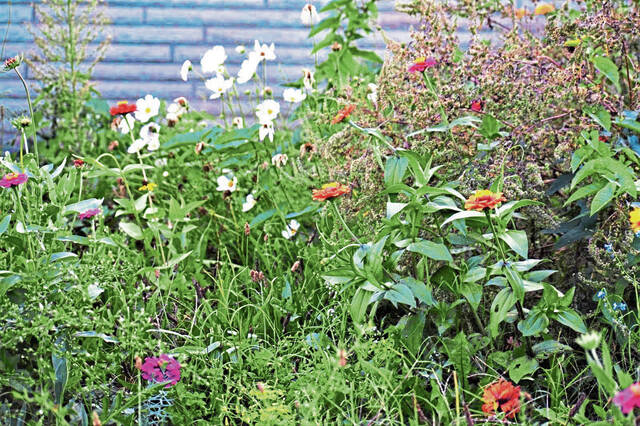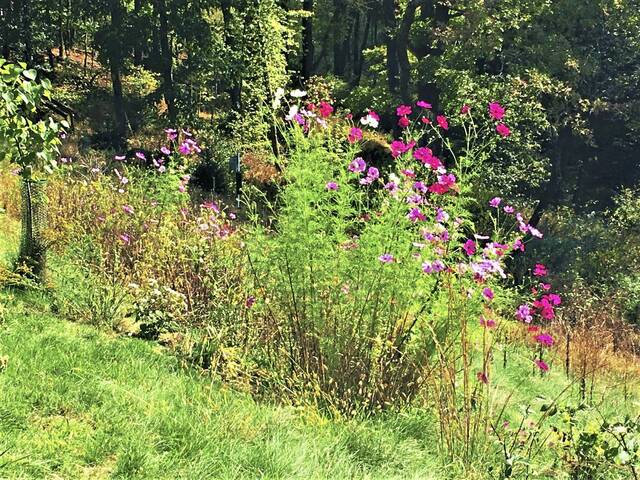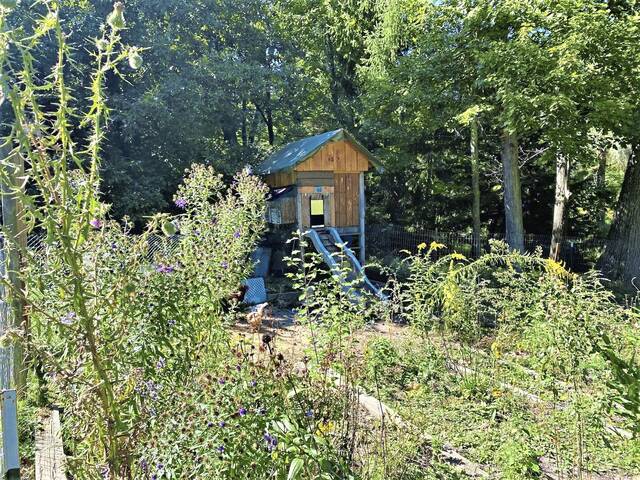Nature center program to replace lawns with wildlife habitat serves as ‘anti-grassroots’ campaign to improve environment
For many people, the lush green lawn and meticulously landscaped gardens surrounding their homes can be like a slice of heaven.
But no matter how beautiful or verdant, when it comes to supporting the ecosystem, most lawns and gardens are hell on earth, experts say.
To help combat what environmentalists characterize as “ecologically deserted” lawns, the Latodami Nature Center in North Park partnered with the North Area Environmental Council for a program to distribute kits for people to convert a 100-square-foot lawn space into a wildlife habitat.
While sale of the kits is over for its inaugural season, all the information is available from the nature center along with instructional videos on how to do the lawn conversion. The information is on the NAEC website, naecwpa.org, under “Lawn to Nature.”
Latodami naturist Ken Knapp said the “lawn to nature” movement was developed by Doug Tallamy, a professor of entomology at the University of Delaware. He is promoting a concept he calls Homegrown National Park, which challenges people to help regenerate biodiversity by converting a portion of a lawn into a wildlife habitat.
The “one lawn at a time” approach is important because such a transformation won’t happen if it is limited to public land, Knapp said.
“Only 20 percent of the land in the U.S. is public,” he said. “So this problem has to be solved on private property.”
Beth Dutton, president of the North Area Environmental Council, said members of her organization became interested in Tallamy’s work at about the time Latodami contacted them about working together on the wildlife habitat kits.
“We thought it was a great idea and decided to help them by promoting it along with our annual seedling sale and donating some funds toward the project,” Dutton said.
The $20 kits distributed this spring by Latodomi to coincide with the North Area Environmental Council’s annual seedling sale included seeds to plant a 10-foot by 10-foot plot of wildflowers, instructions on how to prepare the soil and a sapling to grow a red oak or chokecherry tree, which is also a critical part of restoring the native bird population.
“Native trees like oak, cherry and willow are called keystone species because they are host plants for various butterfly and moths’ larvae and can help support more than 400 different species,” he said.
“Having one of these trees is like having a cafeteria for birds and a great way to bring nature to your home,” Knapp said.
The foundation for improving the ecology with wildlife habitats is increasing the native insect population, according to Knapp.
“Insects are the basis for everything,” he said. “As our insect population has plummeted, we’ve had a dramatic decrease in the bird population.”
Latodami is helping to support the park’s bird population with a program to provide hundreds of nesting boxes to increase the species’ population.
According to the National Audubon Society, in 2019 North America was home to nearly 3 billion fewer birds in 2019 compared to 1970, which is a decline of more than 1 in 4 birds.
The proliferation of lawns — and the way they are tended — along with ornamental gardens planted with non-native species are a recipe for killing off wildlife, Knapp said.
“There are 40 million acres of lawn in the United States that don’t provide much ecological value whatsoever,” he said. “And they’re really bad if you are throwing down fertilizer and herbicides.”
He said the best thing a lawn can have is the thing that people are spending money and time to eradicate: “We’re killing weeds such as dandelions and clover, which are pollinators and the only thing of any value in a lawn,” Knapp said.
Lawns also do a bad job at managing stormwater.
“The root system of typical sod grass is really shallow,” he said. “Rainwater runs off a lawn so easy that it’s almost as bad as impermeable surfaces like asphalt and concrete.”
Ray Morris, 80, of Pine, who volunteers at Latodami, said after retiring, he “upsized” from a townhouse with almost no land to a home on a more than 1-acre plot.
“The agent told me it was the worst landscaped lot in the neighborhood, so I decided to turn a portion of it into a pollinator garden instead of putting in grass or plants that serve no purpose,” he said.
Morris took a 5-foot by 60-foot section, removed the ground cover and planted it with a variety of wildflowers such as cosmos, brown-eyed susans and goldenrod.
“I have bluebird nesting boxes on my property, so I was already seeing more wildlife, but after putting in the wildflower garden I started seeing a lot more butterflies and bees showing up.”
Morris said it can sometimes take an entire season, so seeds that are planted have a chance to break down during the winter-to-spring freeze-and-thaw cycle.
But seeds also can be germinated indoors and then replanted once the weather breaks.
While some people take a more random approach when installing a wildflower garden by simply scattering the seeds in an area, Morris said the seeds can also be planted to create features and effects in a garden by arranging them by height and the color of their blooms.
Many of the plants, shrubs and flowers planted in ornamental gardens also do little to promote biodiversity.
“Most of the pretty stuff being used isn’t from around here, which means insects don’t recognize it and don’t feed on it or live in it,” Knapp said. “It might be attractive, but it serves no ecological purpose.”
Turning part of a lawn into a wildlife habitat also is less work, Dutton said.
“There’s no other plant besides a lawn that requires weekly pruning,” she said. “And if it’s being done with a gas mower, it’s producing more air pollution than a car.”
Dutton concedes that the movement to reduce lawns will require a change in the perception of what is beautiful.
“There’s such a tidy aesthetic when it comes to yards, especially in the North Hills,” she said. “But people can work with a landscaper to create a wildlife habitat that is both useful for the environment and beautiful.”
Tony LaRussa is a TribLive reporter. A Pittsburgh native, he covers crime and courts in the Alle-Kiski Valley. He can be reached at tlarussa@triblive.com.
Remove the ads from your TribLIVE reading experience but still support the journalists who create the content with TribLIVE Ad-Free.

